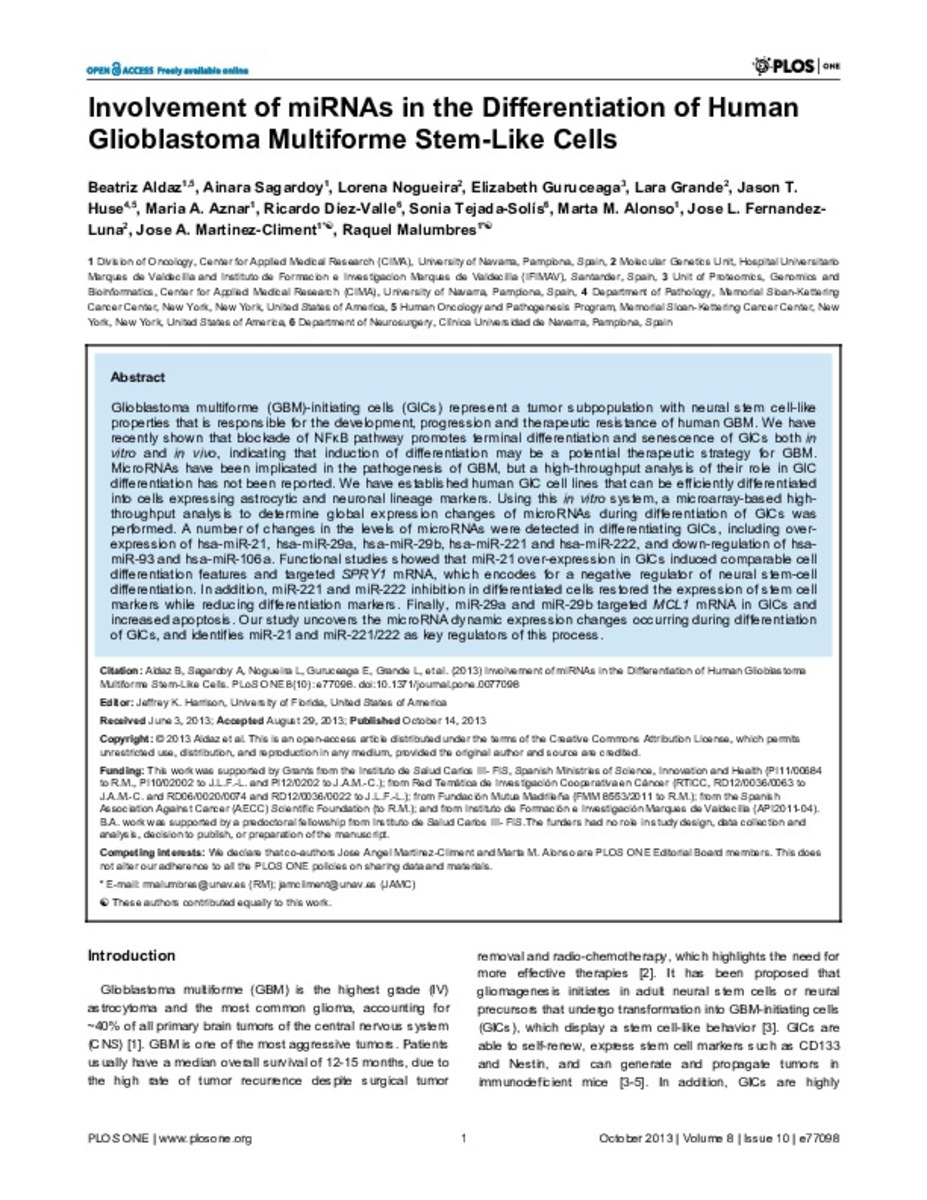Full metadata record
| DC Field | Value | Language |
|---|---|---|
| dc.creator | Aldaz-Arrieta, B. (Beatriz) | - |
| dc.creator | Sagardoy, A. (Ainara) | - |
| dc.creator | Nogueira, L. (Lorena) | - |
| dc.creator | Guruceaga, E. (Elizabeth) | - |
| dc.creator | Grande, L. (Lara) | - |
| dc.creator | Huse, J.T. (Jason T.) | - |
| dc.creator | Aznar, M.A. (María Ángela) | - |
| dc.creator | Diez-Valle, R. (Ricardo) | - |
| dc.creator | Tejada-Solis, S. (Sonia) | - |
| dc.creator | Alonso-Roldán, M.M. (Marta María) | - |
| dc.creator | Fernandez-Luna, J.L. (J.L.) | - |
| dc.creator | Martinez-Climent, J.A. (José Ángel) | - |
| dc.creator | Raquel | - |
| dc.date.accessioned | 2014-08-23T11:45:14Z | - |
| dc.date.available | 2014-08-23T11:45:14Z | - |
| dc.date.issued | 2013 | - |
| dc.identifier.citation | Aldaz B, Sagardoy A, Nogueira L, Guruceaga E, Grande L, Huse JT, et al. Involvement of miRNAs in the differentiation of human glioblastoma multiforme stem-like cells. PLoS One. 2013 Oct 14;8(10):e77098 | es_ES |
| dc.identifier.issn | 1932-6203 | - |
| dc.identifier.uri | https://hdl.handle.net/10171/36375 | - |
| dc.description.abstract | Glioblastoma multiforme (GBM)-initiating cells (GICs) represent a tumor subpopulation with neural stem cell-like properties that is responsible for the development, progression and therapeutic resistance of human GBM. We have recently shown that blockade of NFκB pathway promotes terminal differentiation and senescence of GICs both in vitro and in vivo, indicating that induction of differentiation may be a potential therapeutic strategy for GBM. MicroRNAs have been implicated in the pathogenesis of GBM, but a high-throughput analysis of their role in GIC differentiation has not been reported. We have established human GIC cell lines that can be efficiently differentiated into cells expressing astrocytic and neuronal lineage markers. Using this in vitro system, a microarray-based high-throughput analysis to determine global expression changes of microRNAs during differentiation of GICs was performed. A number of changes in the levels of microRNAs were detected in differentiating GICs, including over-expression of hsa-miR-21, hsa-miR-29a, hsa-miR-29b, hsa-miR-221 and hsa-miR-222, and down-regulation of hsa-miR-93 and hsa-miR-106a. Functional studies showed that miR-21 over-expression in GICs induced comparable cell differentiation features and targeted SPRY1 mRNA, which encodes for a negative regulator of neural stem-cell differentiation. In addition, miR-221 and miR-222 inhibition in differentiated cells restored the expression of stem cell markers while reducing differentiation markers. Finally, miR-29a and miR-29b targeted MCL1 mRNA in GICs and increased apoptosis. Our study uncovers the microRNA dynamic expression changes occurring during differentiation of GICs, and identifies miR-21 and miR-221/222 as key regulators of this process. | es_ES |
| dc.language.iso | eng | es_ES |
| dc.publisher | Public Library of Science | es_ES |
| dc.rights | info:eu-repo/semantics/openAccess | es_ES |
| dc.subject | Glioblastoma | es_ES |
| dc.subject | Neurons | es_ES |
| dc.subject | Beta III-tubulin protein, human | es_ES |
| dc.subject | Glial fibrillary acidic protein | es_ES |
| dc.subject | Myeloid cell leukemia sequence 1 protein | es_ES |
| dc.subject | Tumor markers | es_ES |
| dc.subject | Gene expression regulation | es_ES |
| dc.title | Involvement of miRNAs in the differentiation of human glioblastoma multiforme stem-like cells | es_ES |
| dc.type | info:eu-repo/semantics/article | es_ES |
| dc.identifier.doi | http://dx.doi.org/10.1371/journal.pone.0077098 | es_ES |
Files in This Item:
Statistics and impact
Items in Dadun are protected by copyright, with all rights reserved, unless otherwise indicated.






